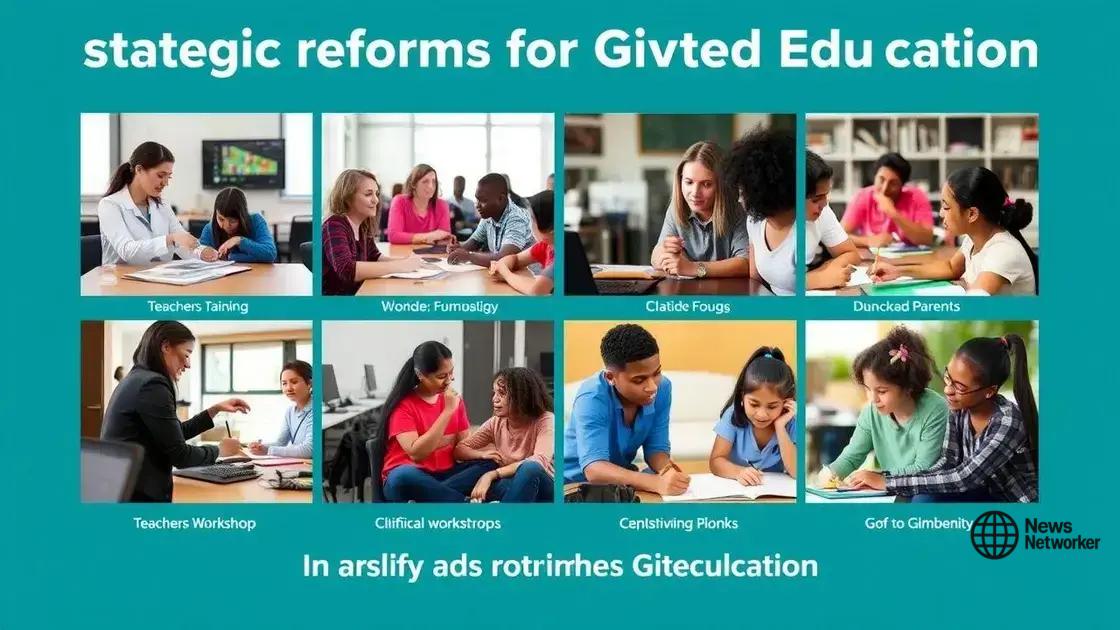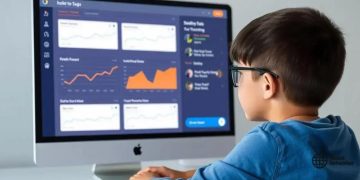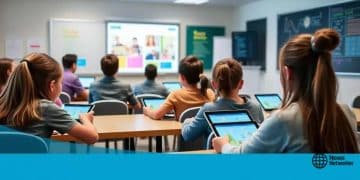Gifted program access reforms: unlocking educational opportunities

Gifted program access reforms focus on enhancing identification, support, and opportunities for gifted students through personalized learning, community engagement, and innovative technologies, ensuring equitable access for all.
Gifted program access reforms are crucial for creating a more equitable educational landscape. Have you ever wondered how these reforms can change opportunities for students? Let’s dive into this important topic.
Understanding gifted programs and their importance
Understanding gifted programs is essential for fostering the potential of students who display advanced abilities. These programs provide enriched educational experiences and help cultivate their unique talents.
Gifted programs are designed to cater to students who might not thrive in standard educational settings. They focus on challenging the intellect and creativity of these students, guiding them toward achieving their full potential.
The Role of Gifted Programs
In schools, gifted programs play a crucial role by:
- Identifying and nurturing students’ unique talents.
- Providing advanced curriculum and enrichment opportunities.
- Encouraging critical thinking and problem-solving skills.
- Creating an environment that fosters collaboration and innovation.
Each school district may implement different structures for their gifted programs, but they all aim to support students who require more than the traditional curriculum can offer. For example, students in these programs often engage in complex projects and participate in competitions that stretch their abilities.
Benefits of Gifted Programs
Participating in a gifted program offers numerous benefits:
- Enhanced academic performance and motivation.
- Opportunities for social interaction with like-minded peers.
- Access to specialized resources and mentorship.
- Preparation for advanced educational paths and careers.
Ultimately, the importance of gifted programs lies in their ability to recognize and nurture students’ exceptional capabilities, providing them with a pathway to success and fulfillment.
Current challenges in access to gifted education
Current challenges in access to gifted education can severely limit opportunities for many bright students. Understanding these challenges is essential to creating effective reforms.
Many schools struggle with identifying students who qualify for gifted programs. There is often an over-reliance on standardized tests, which may not fully capture a student’s potential. This can lead to an inaccurate representation of a child’s abilities.
Barriers to Identification
Some key barriers include:
- Lack of awareness about how to spot giftedness beyond academics.
- Imbalanced evaluation methods that favor certain demographics.
- Insufficient training for teachers and staff in recognizing gifted traits.
- Financial limitations that restrict testing and resources.
The results can be frustrating for both educators and students. Many gifted students may slip through the cracks, missing out on the support they need. Meanwhile, schools may be unaware of the diverse needs of these students.
Socioeconomic Factors
Socioeconomic status also plays a significant role in access to gifted education. Students from low-income backgrounds may not have the same opportunities to showcase their talents. They could lack access to enrichment programs, which are critical for developing their skills.
Furthermore, cultural biases can affect how students are perceived in terms of their potential. This could lead to certain groups being unfairly excluded from gifted programs. Addressing these biases is vital for ensuring equitable access for all students.
Advocating for better evaluation methods and increased teacher training can help pave the way for more inclusive gifted education systems. It is essential to start these conversations in schools to ensure no student is overlooked.
Strategies for effective access reforms

Implementing effective access reforms for gifted education can create equal opportunities for all students. These reforms should be thoughtfully designed to meet diverse needs.
One key strategy is to enhance identification processes. Schools should use a combination of assessments, including teacher recommendations and portfolios. This approach helps recognize talents that standardized tests may miss.
Building Awareness and Training
An important part of the reform is building awareness among educators. Training teachers to identify gifted students from various backgrounds is essential. Professional development programs should focus on recognizing a wide range of abilities and supporting those students.
- Workshops on understanding giftedness.
- Training on diverse evaluation methods.
- Encouraging collaboration among educators.
- Providing resources for ongoing support.
Additionally, schools must communicate openly with families. Engaging parents in the process can foster a better understanding of how to support their children. Schools can hold informational sessions to highlight the benefits of gifted programs and how families can be involved.
Implementing Inclusive Policies
Another effective strategy involves crafting inclusive policies. These policies should ensure that all students have the same access to gifted education opportunities, regardless of their background.
Inclusion can be strengthened by:
- Reviewing admission criteria for fairness.
- Expanding participation in enrichment activities.
- Offering scholarships or funding for underserved families.
- Establishing mentorship programs for students at risk of being overlooked.
Establishing partnerships with community organizations can further enhance resources available to gifted students. By leveraging external support, schools can widen access and provide enriched experiences.
Case studies of successful reforms in schools
Examining case studies of successful reforms in schools provides valuable insights into effective practices for gifted education. These examples highlight how various strategies can significantly enhance student outcomes.
One remarkable case is that of a school district in California that revamped its identification process for gifted programs. Initially, the district relied heavily on standardized testing. However, it shifted to a more holistic approach, incorporating teacher observations and student portfolios. This change resulted in a 30% increase in diversity among students identified as gifted.
Expanding Access through Community Engagement
Another successful reform can be found in a New York City high school that focused on community engagement. The administration partnered with local organizations to offer workshops and information sessions for parents. This initiative aimed to raise awareness about gifted education and demystify the admission process. As a result, the school saw a 40% increase in applications from underrepresented families.
- Parents received guidance on how to support their children.
- Students participated in enrichment programs designed to challenge their skills.
- Increasing family involvement led to a stronger, supportive community.
Furthermore, a Texas school implemented mentorship programs linking gifted students with local professionals. These connections provided real-world experiences and inspiration. Students were more motivated and engaged, resulting in notable improvements in their academic performance.
Innovative Curriculum Development
In another example, a Colorado school district adopted an innovative curriculum tailored for gifted learners. They focused on project-based learning, allowing students to explore their interests deeply. This method encouraged creativity and critical thinking by providing opportunities to work on real-life problems.
As a consequence, students expressed higher levels of satisfaction with their educational experience. Teachers noted a 50% increase in student engagement during lessons, showcasing how tailored educational experiences can lead to exceptional growth.
The future of gifted education access initiatives
The future of gifted education access initiatives looks promising as schools begin to implement innovative strategies to foster inclusivity. Constant advancements in educational techniques are paving the way for a more equitable system.
One major trend is the integration of technology in identifying and supporting gifted students. Schools are utilizing data analytics to enhance their selection processes. By analyzing performance metrics from various sources, they can better identify potential in students who may otherwise be overlooked.
Personalized Learning Plans
Future initiatives may lean heavily on personalized learning plans designed specifically for gifted learners. These plans can address individual strengths and weaknesses, allowing each student to progress at their own pace.
- Regular assessments to adjust learning plans.
- Flexible curriculum options that challenge students.
- Incorporating student interests to boost engagement.
- Encouraging mentorship and peer collaboration.
By creating tailored educational experiences, schools can ensure that all gifted students receive the support they need to thrive. Additionally, this strategy promotes greater student investment in their learning journey.
Inclusive Policies and Outreach
Looking ahead, there is also a movement toward more inclusive policies that actively reach out to diverse populations. Schools are starting to recognize the importance of representation in gifted programs. Outreach initiatives targeting underrepresented communities are essential for creating a balanced and fair educational environment.
As schools implement these changes, community partnerships will become increasingly vital. Collaborating with local organizations can expand resources and support for students from different backgrounds. This collaboration can also help in training educators on cultural competency, which is crucial for understanding diverse learning needs.
Ultimately, the future of gifted education access initiatives is about striving for balance and fairness. With the right strategies in place, we can create an educational landscape where every child, regardless of their background, has the opportunity to excel.
In conclusion, the journey toward improving access to gifted education is essential for creating a fair and equitable learning environment. Schools are beginning to implement innovative strategies to identify and nurture students’ unique talents. By focusing on personalized learning and inclusivity, we can ensure every child has the opportunity to thrive. Community engagement and diverse outreach initiatives further enrich the educational landscape, leading to brighter futures for gifted learners. Together, these efforts can shape a more inclusive system, unlocking potential for all students.
FAQ – Frequently Asked Questions about Gifted Education Access Reforms
What are gifted education access reforms?
Gifted education access reforms are initiatives aimed at improving the identification and support of gifted students, ensuring all have equal opportunities to succeed.
How do personalized learning plans help gifted students?
Personalized learning plans tailor education to individual strengths and weaknesses, allowing gifted students to learn at their own pace and focus on their interests.
Why is community engagement important in gifted education?
Community engagement fosters partnerships that provide additional resources and support, helping to create a more inclusive environment for gifted learners.
What role does technology play in identifying gifted students?
Technology helps schools analyze performance data more effectively, enhancing the identification process and ensuring that all potential gifted students are recognized.





